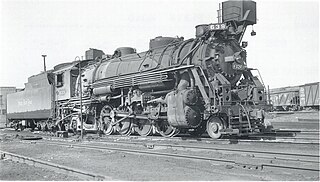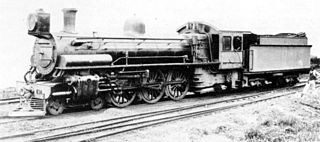
Under the Whyte notation for the classification of steam locomotives, 2-8-2 represents the wheel arrangement of two leading wheels on one axle, usually in a leading truck, eight powered and coupled driving wheels on four axles and two trailing wheels on one axle, usually in a trailing truck. This configuration of steam locomotive is most often referred to as a Mikado, frequently shortened to Mike.

Under the Whyte notation for the classification of steam locomotives by wheel arrangement, 2-6-2+2-6-2 is an articulated locomotive using a pair of 2-6-2 power units back to back, with the boiler and cab suspended between them. The 2-6-2 wheel arrangement has a single pair of leading wheels in a leading truck, followed by three coupled pairs of driving wheels and a pair of trailing wheels in a trailing truck.

The South African Railways Class 11 2-8-2 of 1904 was a steam locomotive from the pre-Union era in Transvaal Colony.

The South African Railways Class 10C 4-6-2 of 1910 was a steam locomotive from the pre-Union era in Transvaal.

The South African Railways Class 10B 4-6-2 of 1910 was a steam locomotive from the pre-Union era in Transvaal.

The South African Railways Class 8 4-8-0 of 1902 was a steam locomotive from the pre-Union era in the Cape of Good Hope.

The South African Railways Class 8A 4-8-0 of 1902 was a steam locomotive from the pre-Union era in Transvaal.

The South African Railways Class 8C 4-8-0 of 1903 was a steam locomotive from the pre-Union era in Transvaal Colony.

The South African Railways Class 8D 4-8-0 of 1903 was a steam locomotive from the pre-Union era in the Cape of Good Hope.

The South African Railways Class 7A 4-8-0 of 1896 was a steam locomotive from the pre-Union era in the Cape of Good Hope.

The South African Railways Class 7B 4-8-0 of 1900 was a steam locomotive from the pre-Union era in Transvaal.

The South African Railways Class 7D 4-8-0 of 1915 was a steam locomotive.

The South African Railways Class 3 4-8-2 of 1909 was a steam locomotive from the pre-Union era in the Colony of Natal.

The South African Railways Class GK 2-6-2+2-6-2 of 1923 was an articulated steam locomotive from the New Cape Central Railway era.

The South West African Class Hd 2-8-2 of 1912 was a narrow gauge steam locomotive from the German South West Africa era.
The South African type XM2 tender was a steam locomotive tender from the pre-Union era in Transvaal.

The South African type XE1 tender was a steam locomotive tender from the pre-Union era in the Cape of Good Hope.

The South African type XF2 tender was a steam locomotive tender from the pre-Union era in the Cape of Good Hope.
The South African type XJ tender was a steam locomotive tender.
The South African type XS tender was a steam locomotive tender from the pre-Union era in Transvaal.


















